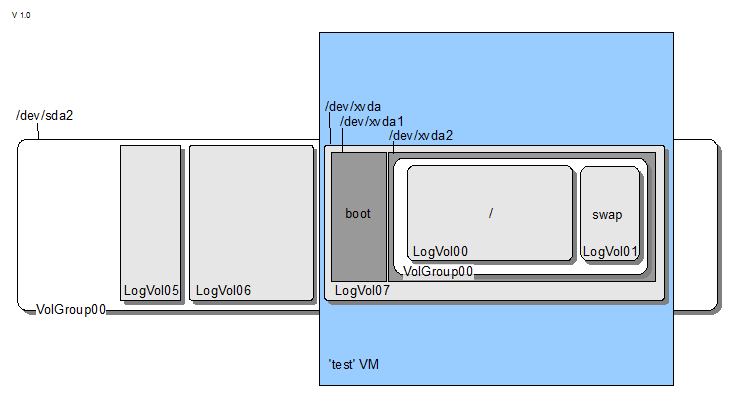Logical Volume Management and Virtualization
Internal
TODO
Objective: to be able to shrink the disk space of the guest: I am at the stage where I can access an off-line block device of a guest vm and "explode" it with kpartx, but then I can't interact with the physical device that contains the volume group because of the name conflict between "VolGroup00" of the host and "VolGroup00" of the guest. Need more investigation.
Overview
One of the most common configurations of disk allocation for Xen guest virtual machines during installation is to specify a logical volume as the main (and only) "disk" for the guest VM.
Let's consider the case of a physical host ('tahiti') that runs multiple guest virtual machines and allocates for each of its virtual machines a single logical volume.
All tahiti's logical volumes are part of a single Volume Group (/dev/VolGroup00) installed on a physical SCSI device (/dev/sda2), of 700GB. We are going to install the "test" virtual machine, and we create a 20GB "test" logical volume for it:
LV Name /dev/VolGroup00/test VG Name VolGroup00 LV UUID o9im2e-haPN-PKqa-RALQ-YALw-O4sA-WOXThJ LV Write Access read/write LV Status available # open 0 LV Size 20.00 GB Current LE 640 Segments 1 Allocation inherit Read ahead sectors auto - currently set to 256 Block device 253:7
During the virtual machine installation procedure we specified /dev/VolGroup00/test as the "disk" and this was pretty much all we specified. The virt-install installation utility "partitions" the disk as necessary.
As result of the installation, /dev/VolGroup00/test becomes a partitioned block device, similar to a physical disk with its own partition table.
fdisk can be used to take a look at the partition table from the host system:
root@tahiti mnt]# fdisk /dev/VolGroup00/test
[...]
Disk /dev/VolGroup00/test: 21.4 GB, 21474836480 bytes
255 heads, 63 sectors/track, 2610 cylinders
Units = cylinders of 16065 * 512 = 8225280 bytes
Device Boot Start End Blocks Id System
/dev/VolGroup00/test1 * 1 13 104391 83 Linux
/dev/VolGroup00/test2 14 2610 20860402+ 8e Linux LVM
The installation utility creates two partitions ('test1' and 'test2'). 'test1' is a bootable partition of type 83 (linux native partition) of about , and 'test2' is a Linux Logical Volume Manager partition (8e) of 19.88 GB. For a list of partition identifiers, take a look here: http://www.win.tue.nl/~aeb/partitions/partition_types-1.html
The logical volume /dev/VolGroup00/test is seen by the "test" guest virtual machine as /dev/xvda. fdisk can also be used from the guest virtual machine and returns the following:
[root@test dev]# fdisk /dev/xvda
[...]
Disk /dev/xvda: 21.4 GB, 21474836480 bytes
255 heads, 63 sectors/track, 2610 cylinders
Units = cylinders of 16065 * 512 = 8225280 bytes
Device Boot Start End Blocks Id System
/dev/xvda1 * 1 13 104391 83 Linux
/dev/xvda2 14 2610 20860402+ 8e Linux LVM
Upon boot, the "test" guest virtual machine uses these two partitions as follows:
/dev/xvda1 and mounted as "/boot".
/dev/xvda2 is used entirely for the volume group VolGroup00 (19.88 GB), containing to logical volumes:
/dev/VolGroup00/LogVol00 of 18.84 G. It contains an ext3 file system and it is mounted as root.
and
/dev/VolGroup00/LogVol01 of 1.03 GB. It is used as swap.
Accessing the "guest" VolumeGroup from the host
The guest main (and only) Volume Group can be accessed and manipulated from the virtualization host via a device map created with kpartx. kpartx is a tool that can be used to make partitions of arbitrary partitioned block devices accessible via /dev/mapper.
In order to access the guest VolumeGroup:
1. Shutdown the 'test' virtual machine.
2. Display /dev/VolGroup00/test's partitions:
[root@tahiti mapper]# cd /dev/mapper [root@tahiti mapper]# kpartx /dev/VolGroup00/test test1 : 0 208782 /dev/VolGroup00/test 63 test2 : 0 41720805 /dev/VolGroup00/test 208
3. Use kpartx to create the device map and "expose" the "/dev/xdva" partitions for manipulation:
cd /dev/mapper kpartx -a /dev/VolGroup00/test
The command will create /dev/mapper/test1 and /dev/mapper/test2, which are block devices exposing access to the block devices known as "/dev/xvda1" and "/dev/xvda2" to the test virtual machine.
The reverse is
kpartx -d /dev/VolGroup00/test
4. /dev/mapper/test2 is the physical device for the virtual machine's volume group:
[root@tahiti mapper]# pvdisplay /dev/mapper/test2 --- Physical volume --- PV Name /dev/mapper/test2 VG Name VolGroup00 PV Size 19.89 GB / not usable 19.49 MB Allocatable yes (but full) PE Size (KByte) 32768 Total PE 636 Free PE 0 Allocated PE 636 PV UUID R4qj4x-FeMY-UmmQ-atKm-PQ2B-OmCg-lvY8Qo
Organizatorium
1: kpartx -a /dev/myvg/mylv 2: Resize partition using fdisk (delete old partition, recreate new one with a larger size, note that the file system remains on the partition) 3: Reboot Dom0 4: kpartx -a /dev/myvg/mylv (again) 5: e2fsck -y /dev/myvg/mylv5 6: resize2fs -p /dev/myvg/mylv5
